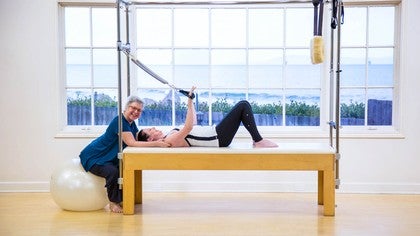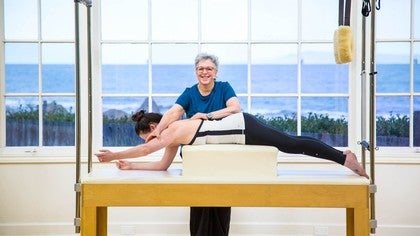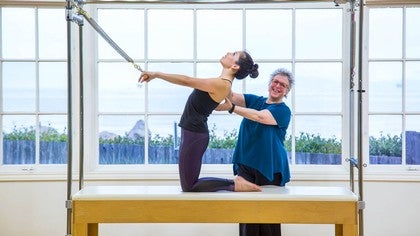Description
About This Video
Transcript
Read Full Transcript
This a tutorial we're going to talk about the triceps and the one reason we're going to talk about the triceps is a lot of times they're not working correctly. And also again, if the phrasing of the shoulder blade is not correct, it's a lot of people are kicking out the triceps. So for instance, a lot of times when you watch somebody push their arm forward, they're straighten the arms, but they really are doing downward rotation. The triceps is really what helps me extend my elbow. And so that's really important for like, um, all the chest rowing front and downward dog. And any year plank pose, the tricep attaches down here, but we're really gonna focus on one of the, the heads come here and one of the heads come there.
And a lot of times, you know, you have your clients do the a hundred, you see them doing this so they're not working the top of the triceps correctly. And by waking this up also can help bring this shoulder girdle to a beautiful width. So now we're going to look at some exercises with Erin and we're going to have a first do it standing. And this exercises a great exercise also for clients with a tennis elbow. And one of the problems with tennis elbow is whether, you know they're playing tennis or they're golfing and they're never extending their arms.
So getting them to train the tricep through full range is really healthy. So we're gonna first do it. Um, I'm going to do one arm at a time. Again, you can see that Aaron's shoulder blade is in downward rotation and if I think about right here is one of the attachments of the Tricep, the humeral head and one comes there. I'm going to bring her shoe, she's going to let me do it. She wants it. So I'm just giving the sense of getting this shoulder blade wide. And then I'm using this hand to glide her clavicle wide. Then she's, and Aaron, um, has very broad shoulders.
So sometimes you might put a pillow or something because you, if she brings her elbow in and tries to straighten, that's really internal rotation. So we want to just really be clear that I want to get her shoulder girdle wide and then let's watch what she does is straightened her arm. So what I feel with her is as she straightens her arm, her humeral head goes forward. So I want her, I'm, I'm kind of tapping her here to and when I don't, oh stay slow. Go ahead. So I'm just trying to get, you can find the tone. Come underneath your hand, straighten that elbow, rotate your forearm in more. Thank you. And then slowly control of back up and go ahead, press down. And Greg, keep your shoulder blade wide, arm pits up. That's it. There you go. So the armpit is a really great reference because underneath the armpits is your ribs. So there's no reason to pull your armpits down.
That's a very terrible cue. And then we're going to look at this shoulder blade. So again, I'm going to bring Aaron shoulder blade, she doesn't, I'm just trying to get that shoulder blade to here, to the curves of her ribs. And then I'm bringing that clavicle up and then she's going to straighten her arm. And I might tap right where my thumb is. There we go. And you can even, if you put you draw on, you can feel the tone come in. That's great. She's going to rotate her forearm in a little better.
That's great. And she, you can see she's doing a great job because this is staying the same relationship. If she pulled down on her armpit, go ahead, do bad version. You can see what happens to the shoulder blade. And if I go up here, I lose tone there. So that's where the, it's so important to get that scapular humeral relationship happening to invite better arm work. Great. Very nice. Thank you. So now we're going to look at, uh, Aaron doing this prone. So she's gonna lie on the table. So we're going to do another tricep exercise. I said prone, but I really meant supine. Um, sometimes I like doing it on the Cadillac because there's not as much range of motion. You can do this all on the reformer as well.
Uh, but sometimes your clients just want to use momentum to get the, uh, action. So before I put her hands into, um, the handles, I want her to bring both arms up towards the ceiling and then we're going to have our bender elbows like so, so remember well, in the beginning of the session we had her do this cue that Irene, a Dowd my teacher taught. So I want her to, with lightness drop the Hume know she's trying to do other things. So remember that rotator cuff muscle is going, it's sucking the bone lightly in, but at the same time she's seen her tipper shoulder blade reached to the ceiling. So she's getting that. Now what I do is the teacher is, I'm bringing my hands underneath and I'm going to tapper because if her shoulder comes off the off my hands, she starting to do downward rotation. So she's going to put her hands in there and she can turn the palms around. There you go. So I want, I'm, I'm going to tap at the top of that tricep and she's going to slowly straighten her arms. Go ahead.
And now she's going to press down just an ounce. There you go. Now I'm feeling a little bit of happening here. Her shoulder blade should be wides. Yes. Then remember the tricep comes from here to up here. I want to press the arm bone down towards the table.
Go ahead a little more. Can you go a little more? There you go. There you go. And I want her to give me a little, I call it a kiss. She's going to kiss her humeral head lightly in my fingertips. She's going to bring her arms up a little bit without losing that humeral head. She's going to push down. Go ahead. Push down more and more and more.
More and more and more, more and more, more little. She that right side doesn't want to work. There you go. Now Bend your elbows without changing. There we go. And now she's going to straighten her arms out and there we go. So a lot of times when I'm doing hundreds on the reformer, I don't let my clients go down until they know how to move the arm without moving the shoulder blade because that's going to really work their triceps correctly. And it looks like a simple exercise.
But she's working hard right now. Come up to standing for us and let's look at her shoulder blades again. So face towards the, um, there we go. And if you look at it, it's really lovely. It's starting to get wider and if we turn her around, you can see that that humeral head.
See what's so nice about it is we want to get the humeral head living a little bit more back in the socket for her, um, which eventually that is going to help train the rotator cuff muscles at their optimal length. If I'm living this way, the rotator cuff muscles are not working correctly and some are not working at all or tightening up. So getting this mechanics is going to be really terrific for you. So we've brought Aaron's shoulder girdle, especially that humeral head in a lovely, um, placement. Now we're going to go into the one wonderful muscle that is called your trapezius that will help bring the shoulder blades down.
Embodied Anatomy: Upper Body
Comments
You need to be a subscriber to post a comment.
Please Log In or Create an Account to start your free trial.









